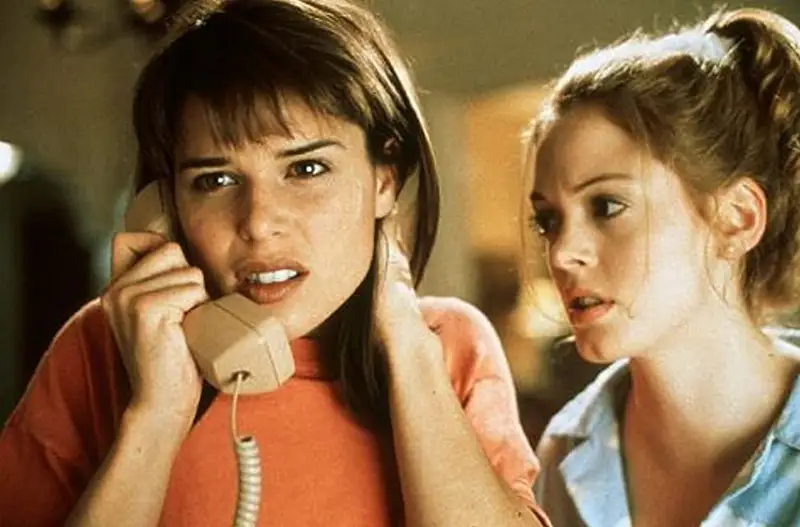Wes Craven’s Scream (1996) seamlessly blends jokes and scares for a twisty, meta look at the clichés of slasher movies.
Director: Wes Craven
Genre: Horror, Slasher
Run Time: 111′
Rated: R
U.S. Release: December 20, 1996
U.K. Release: May 2, 1997
Where to Watch: Digital & VOD
“There are certain rules which one must abide by in order to successfully survive a horror movie,” film geek Randy Meeks exclaims to a group of drunken teenagers in Wes Craven’s 1996 classic Scream. Scream is a movie about the act of talking about movies. From the beginning of cinema, characters have been attending the movie theater, referencing movies as a joke, and even making movies.
Scream takes it a step farther and works its way just shy of the fourth wall, having characters discuss and deconstruct the very type of movie they are in, the slasher horror flick. Perhaps certain exchanges between the characters could mimic conversations that the audience is having at the exact same time. Then, Scream uses the audience’s own expectations and knowledge of movies against them for finely modulated sequences of white-knuckle suspense.
The movie begins with a sequence so deftly directed and so terrifying that it threatens to upset the balance of the rest of the movie. High school student Casey Becker (Drew Barrymore) is alone in a window-covered house, heating up Jiffy Pop on the stove and preparing for a night of horror movies when she receives an unusual phone call. At first the voice on the phone is disconcerting, then annoying, then friendly, and, finally, threatening. “Why do you want to know my name?” Casey asks at one point. “Because I want to know who I’m looking at,” the voice replies. They challenge her to a horror movie trivia game. If she gets a question, such as who was the killer in Friday the 13th?, she will be killed. Casey’s parents return home to find her mangled corpse hanging from a tree in the front yard.
News of the gruesome murder spread throughout the small Wine Country town of Woodsboro, California stoking paranoia in the residents, excitement in tabloid journalists such as the ambitious Gale Weathers (Courteney Cox), and flippant jokes from the high school students. The one person who seems to treat the tragedy with any sense of practicality and seriousness is fresh-faced high school student Sdyney Prescott (Neve Campbell), whose mother was murdered nearly a year earlier. Perhaps the two murders are connected. Campbell makes for an engaging final girl, giving Sydney a quick-thinking wit and intelligence. She’s very easy to root for.
Before you can say “Michael Myers,” the killer strikes again. And wouldn’t you know it, on just the weekend when Sydney’s father is away for work, and her boyfriend, Billy Loomis’s (Skeet Ulrich) best friend Stu Macher (Matthew Lillard), decides to throw a house party. Wearing a dime store costume called ‘Father Death” the mask clad killer terrorizes Sdyney and a cadre of hip pop culture literates, as they attempt to use their knowledge of horror movies to survive.
The script from Kevin Williamson seamlessly blends together laughter and thrills. While the movie has laugh-out-loud jokes, it is not Airplane!, and, at the same time, the quips and pratfalls do not deflate the moments of suspense. They feed into one another, the jokes making the scares even stronger, and the scares making the jokes more pointed and black. Through the cleverness of Craven and Williamson, the movie succeeds not just as a send-up of slasher movies, but as a genuine mystery, with intriguing twists and turns, clues, and red herrings.
It is the more satirical elements of Scream that give me pause. As the references to previous horror movies and their clichés are littered throughout, not only in the dialogue, but the plot machinations, I would not recommend the movie to anyone without a working knowledge of the genre. I’m not sure how the movie would play if you, for instance, haven’t seen Halloween. Someone with knowledge of horror movies probably wouldn’t find scenes where characters discuss whether or not the killer in a slasher needs a motivation very interesting anyway.

For those with even a faint interest in horror movies, there is much to love about Scream. Even with all of the horrible murders, it has a friendly air, courtesy of the script’s sense of humor and an appealing cast. Rather than sitting the audience down for an academic dissertation on slashers, or, on the other hand, snarking contemptuously at a genre the film doesn’t understand, Scream stands alongside the viewer and lets them in on the jokes and conversation. It doesn’t look down on horror movie geeks, or even the most ridiculous trope found in the movies.
More than that, Scream expects the viewer to talk back; scream, remember other movies, yell at the characters to run out the front door instead of up the stairs, look behind them, or get away from someone who is obviously the killer. With a clever and amused hand, Craven and Williamson deftly engage with the viewer’s own relationship to horror movies.
Scream (1996): Movie Plot & Recap
Synopsis:
A mask-covered killer terrorizes a group of horror movie savvy teens in the small town of Woodsboro.
Pros:
- Funny
- Clever
- Suspenseful
- Well-directed
- Works as both a satire and a mystery
Cons:
- Esoteric. Probably wouldn’t work without a knowledge of slasher movies
- Certain lines haven’t aged well, such as Sydney’s complaint that she’s “sexually anorexic.”
Scream (1996) is now available to watch on digital and on demand.
Loud and Clear Reviews has an affiliate partnership with Apple, so we receive a share of the revenue from your purchase or streaming of the films when you click on some of the links on this page. This won’t affect how much you pay for them and helps us keep the site free for everyone.

